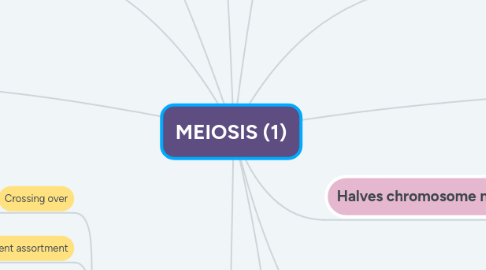
1. Cytokinesis
1.1. 2 daughter
1.2. Haploid
2. Each chromosome duplicated
3. Genetic unique
4. No DNA
5. Halves chromosome number
5.1. Special division
5.2. Sexual
5.3. No prior to fertilize
5.3.1. Haploid gamets
6. Homologous pairs of chromosome
6.1. Pairs
6.2. 23 chromosome
6.3. Same type
6.4. Genes control same trait & position
6.5. Alleles
7. Phase meiosis
7.1. Prophase 1
7.1.1. Synapsis
7.1.2. Usually shorter
7.1.3. Tentrad
7.2. Metaphase 1
7.2.1. Homologous arrange the Meta plate
7.3. Anaphase 1
7.3.1. Sypnasis breaks up
7.3.2. Homologous seperate one to another
7.3.3. Physically allign end to end
7.3.4. Opposite poles
7.4. Telophase 1
7.4.1. Daughter cell duplicate
7.5. Interkinesis
7.5.1. Similar to mitotic interphase
8. Genetic variation
8.1. Crossing over
8.1.1. Exchange genetic material
8.2. Independent assortment
8.2.1. Seperate random
8.2.1.1. Blocks of alleles
8.2.2. Maternal or paternal may be oriented toward pole of mother cell
8.3. Significance
8.3.1. Asexual
8.3.1.1. Clones
8.3.1.2. Chromosome by parents combines
8.3.2. Sexual
8.3.2.1. Genetic recombination
8.4. Fertilization
9. Phase meiosis 2 (similar to mitosis)
9.1. Overview
9.1.1. Unremarkable
9.2. Prophase 2
9.2.1. Chromosome condense
9.3. Metaphase 2
9.3.1. Chromosome allign Meta phase
9.4. Anaphase 2
9.4.1. Centromere dissolve
9.5. Telophase & Cytokinesis 2
9.5.1. 4 haploid
9.5.1.1. Sister becomes daughter
10. Life cycle basics
10.1. Plants
10.1.1. Haploid
10.1.1.1. Gametophyte
10.1.1.2. Larger or smaller than diploid
10.1.2. Diploid
10.1.2.1. Sprophyte
10.1.2.2. Larger or smaller than hiploid
10.2. Animals
10.2.1. Individual are diploid produce haploid gamets
10.2.2. Only part gamet
10.2.3. Gametogeneous
10.2.3.1. Sperm
10.2.3.2. Egg
10.3. Humans
10.3.1. Sperm & egg
10.3.2. Egg fuse to fertilize
10.3.3. Results in zygote
10.3.4. Multicellular embryo that gradually takes features
10.3.5. All growth mitotic division
11. Change
11.1. Number
11.1.1. Euploid
11.1.2. Aneuploid
11.1.2.1. Monosomy
11.1.2.2. Trisomy
11.1.2.2.1. Trisome 21
11.1.2.2.2. Particular 3 chromosomes
11.2. Parents
11.3. Sex
11.3.1. Too many of X or Y chromosome
11.3.1.1. Turner syndrome (XO)
11.3.1.2. Klinefelter syndrome (XXY)
11.4. Structure
11.4.1. To simultaneous breaks lead to loss
11.4.2. Deletation
11.4.2.1. Translocation
11.4.2.1.1. A segment from one chromosome to non-homologous
11.4.2.2. One or both chromosome breaks off
11.4.3. Duplication
11.4.3.1. Chromosome more than one
11.4.4. Inversion
11.4.4.1. Genes occur reverse order in inverted segment
11.4.4.2. The internal segment reversed to before re-insertion
